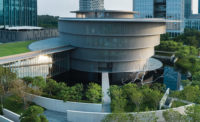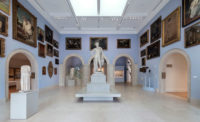Following Ando to the Inland Sea




































On Naoshima, the 3.15-square-mile island in Japan’s Seto Inland Sea that Tadao Ando and other architects have turned into a popular station on the art-world pilgrimage route, the projects keep coming. In March, Sou Fujimoto completed a metal-mesh pavilion on the waterfront that lures visitors and local residents to climb inside its faceted form, while Hiroshi Sambuichi has designed a community center that will serve as a venue for Bunraku, a traditional form of Japanese puppetry, when it opens this fall.
Since 1989, Benesse Holdings and the Fukutake Foundation, a public interest foundation that is one of the major shareholders of Benesse, have been using art and architecture to revitalize Naoshima and some of its neighboring islands, which had been environmentally damaged by industrial operations for much of the 20th century. Ando helped put Naoshima on the map, starting with the Benesse House museum and hotel in 1992, followed by the Chichu Art Museum, the Lee Ufan Museum, and the Ando Museum. In the Art House Project, Ando, as well as individual artists such as James Turrell, Rei Naito and Hiroshi Sugimoto have worked to convert abandoned old houses on the island into site-specific works of art.
On nearby Inujima Island, Sambuichi and artist Yukinori Yanagi created the Seirensho Art Museum within the ruins of a copper refinery and on Teshima Island, Ryue Nishizawa designed Teshima Art Museum, a tear-drop-shaped concrete-shell structure to house an artwork by Rei Naito that employs water, concrete, string, and beads.
When Soichiro Fukutake, the chairman of the board of the Fukutake Foundation and executive advisor to Benesse Holdings, first visited Naoshima, some of its hills had been denuded by copper-smelting and other industrial operations. “I felt angry when I saw this destruction,” said Fukutake in an interview at the Japan Society in New York City, which organized a symposium about Naoshima in April. At first, his goal was just to build a campground, a project that his father had wanted to do.
After the campground opened in 1989, Fukutake’s vision began to grow. Despite its spectacular setting in the Inland Sea about 125 miles west of Osaka, Naoshima had been losing population for decades, as young people moved to big cities. By 2003, it had just 3,600 residents, most of whom were elderly. “My goal was to breathe new life into the island and bring people back,” said Fukutake. “I felt that art and architecture could play a role in this.” By building museums and integrating artworks within the natural and social context, Fukutake hoped to not just attract tourists, but change the people living on Naoshima. In his interview with Record, he explained “the Naoshima Method,” which encourages residents of the island to interact with artists during the creative process and then transmit that knowledge to people who later visit the island. “It makes the elderly feel younger. It makes them happy."
Fukutake talked about one Naoshima resident, a widower, who showed a younger woman around the island and ended up establishing a long relationship with her. “Now, we have lots of elderly men who meet the ferries as they arrive, hoping to find someone too!”
Funding for most of the projects has come from the Fukutake family, the Fukutake Foundation, and Benesse Holdings, the educational services and publishing company established by Fukutake’s father in 1955. “I hope financial capitalism will lead to public-interest capitalism,” stated Fukutake. “The economy should be a servant to culture.”
Weaving art and architecture into the natural setting is a driving force behind many of the projects on Naoshima and its nearby islands. At the Chichu Museum, for example, Ando buried most of the building under a hill, carving out dramatic spaces for works by individual artists such as Walter De Maria, Claude Monet, and James Turrell. “Nature is man’s best teacher,” said Fukutake.
The businessman and benefactor likes to exhort his architects by saying, “Use what exists to create what is to be.” This helps explain Sambuichi’s reuse of the old copper refinery to create the Seirensho Museum on Inujima and the transformation by several architects of old wood houses into art installations. It also provides the impetus for a growing reliance on passive sources of energy, especially at the Seirensho Museum. “I consider architecture to be part of the earth,” asserted Sambuichi at the symposium. For his community center now under construction on Naoshima, the architect designed the building so it would rely only on natural ventilation. Both this building and Fujimoto’s new pavilion in the port area of Naoshima were commissioned by the local government, not the Fukutake Foundation or Benesse.
While the population of Naoshima has remained small, hundreds of thousands of people now visit the place each year. For the Setouchi Triennale, an art event that will take place on Naoshima and some of its neighboring islands over the course of 108 days in 2016, the organizers are expecting close to a million visitors. Whether art can make old people happy is an open question, but it clearly can lure crowds to a few hilly dots in the Inland Sea.

























